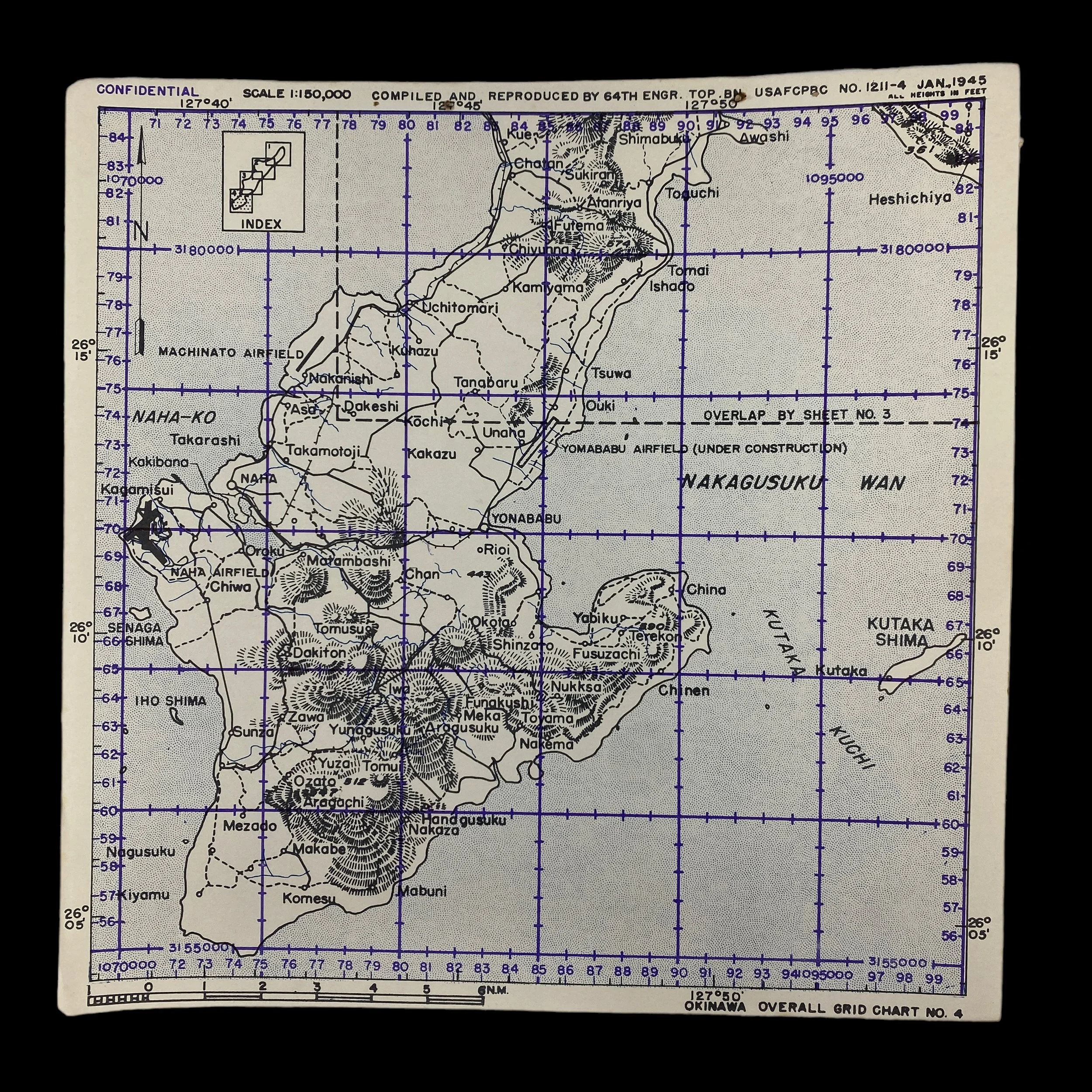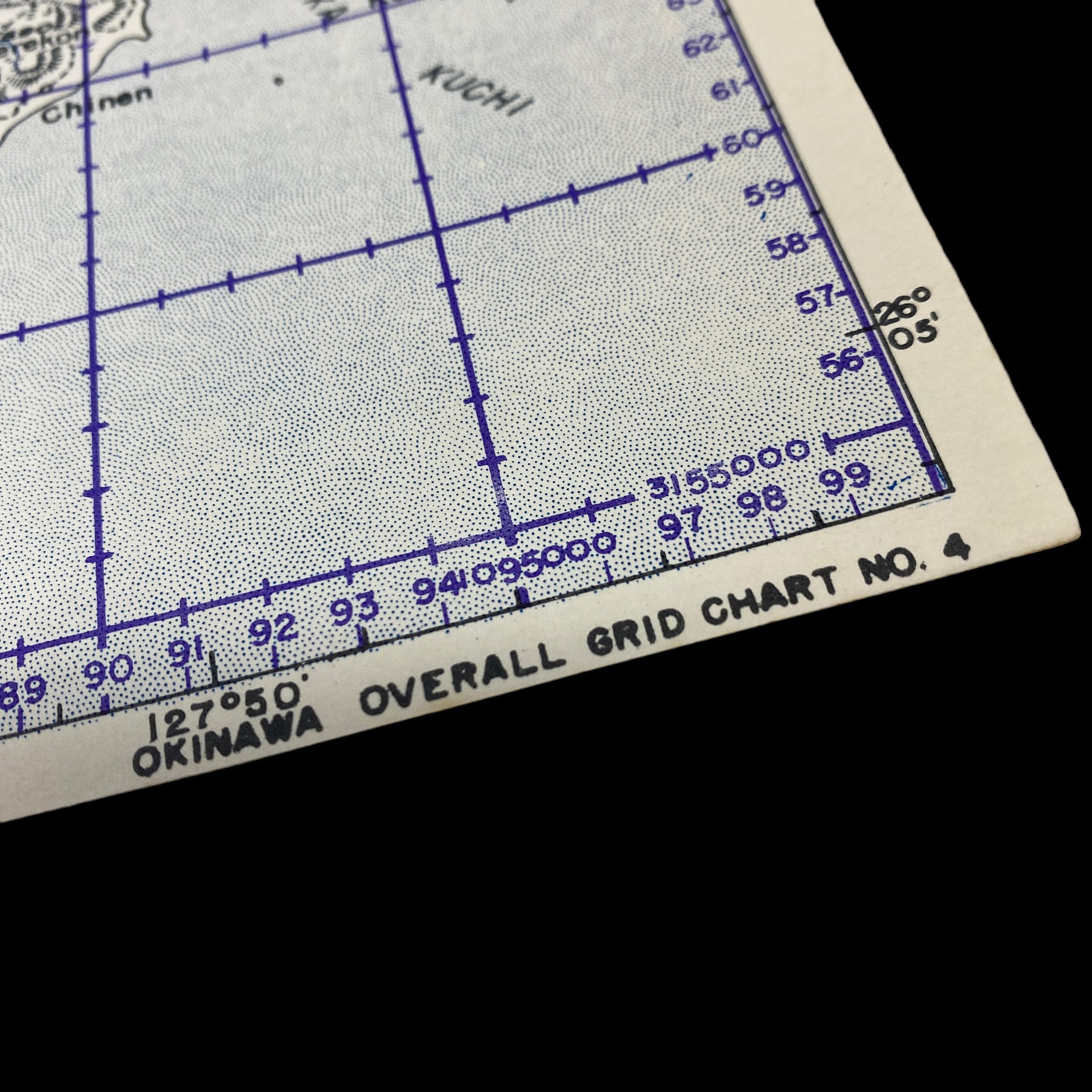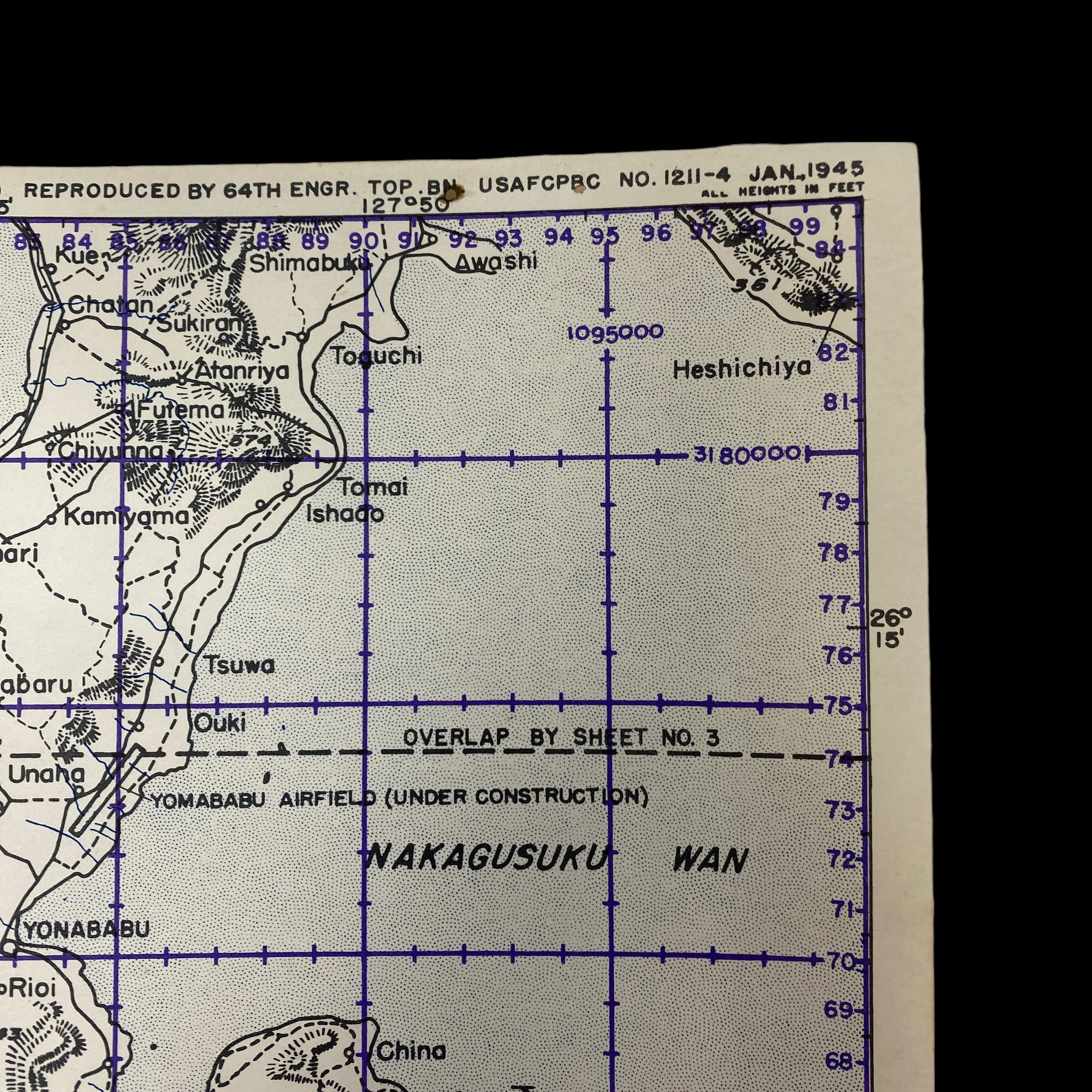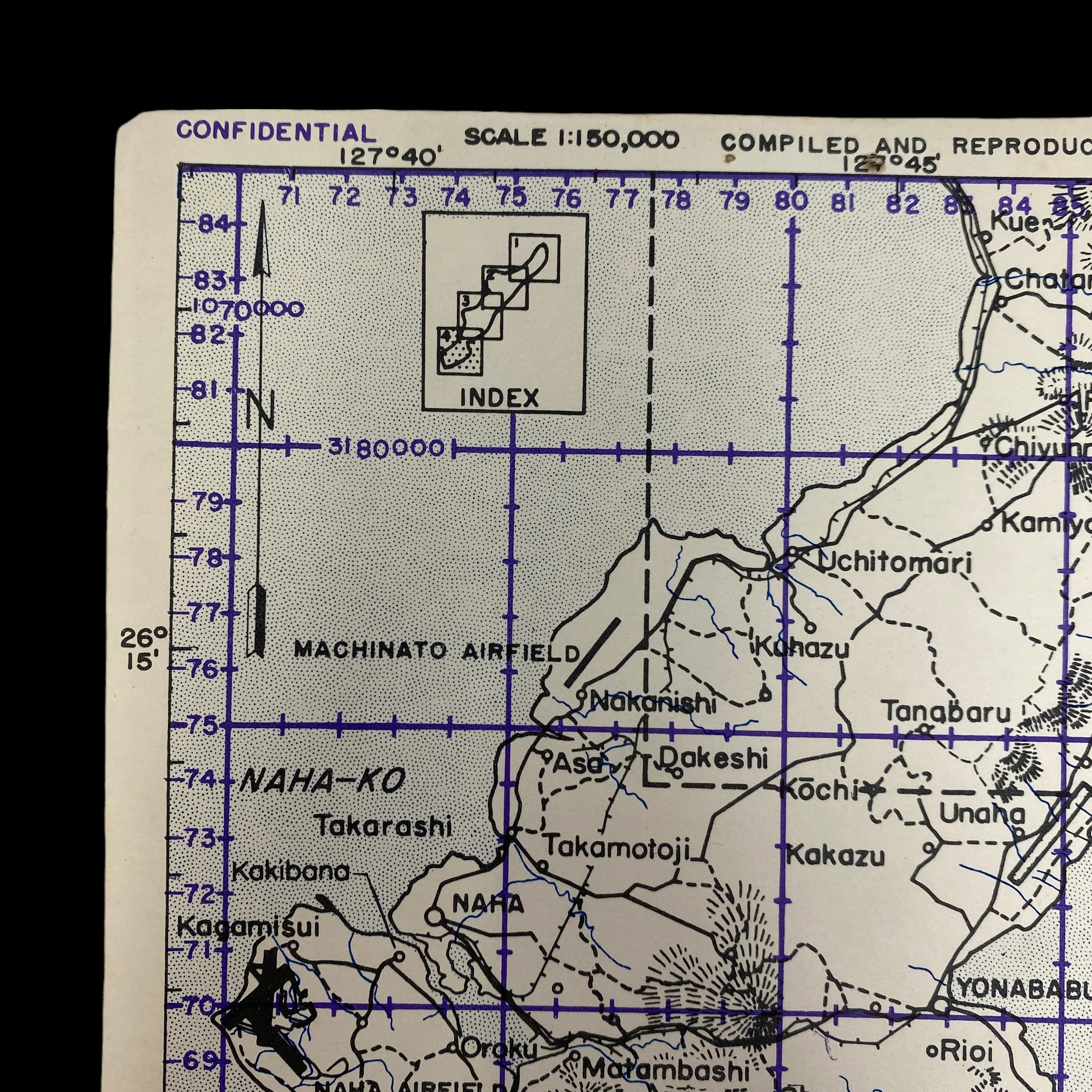RARE! WWII 1945 ‘CONFIDENTIAL’ Okinawa Target NAHA AIRFIELD Grid Lt. Moore U.S.S. Enterprise (CV-6) Air Group


















RARE! WWII 1945 ‘CONFIDENTIAL’ Okinawa Target NAHA AIRFIELD Grid Lt. Moore U.S.S. Enterprise (CV-6) Air Group
Letter of Authenticity included
*FEATURES NAHA AIRFIELD
This extremely rare ‘CONFIDENTIAL’ marked World War II “Okinawa Overal Grid Chart” was complied and reproduced by the 64th Engineer Topographical Battalion (USAFCPBC) on January 1945, three months prior to Operation Iceberg and the American air, land, and naval assault against the heavily defended Japanese island of Okinawa. In the USS Enterprise ‘After Action’ reports it states, “It is recommended that "Top Secret" material - Operation Plans and Orders - be reclassified downward to "Secret or Confidential" prior to the start of an operation by a sufficient length of time to permit of adequate and timely distribution to subordinate officers and pilots concerned.”
Titled ‘Okinawa Overal Grid Chart’ this map was carried and used by Lt. Moore who served as an American pilot on the USS Enterprise (CV-6) Air Group. This rare air target map was carried by Lt. Moore as U.S. aircraft patrols and search and destroy missions were conducted by the USS Enterprise (CV-6) and its Air Group. It was during the assault on Okinawa that Lt. Moore and the USS Enterprise Air Group flew patrols around the clock as kamikaze attacks increased. The battle of Okinawa didn’t stop the Enterprise as it became the locations of two direct kamikaze impacts, one on 11 April and the final on 14 May 1945, she suffered her last wound of World War II when a kamikaze Zero, piloted by Lt. J.G. Shunsuke Tomiyasu, destroyed her forward elevator, killing 13 and wounding 68.
USS Enterprise and Operation Downfall (Okinawa):
Following the USS Enterprise and its Air Group’s support of the Marines in the Battle of Iwo Jima from February 19th through March 9th, the Air Group sought rest after a commendable feat when during that period the Enterprise kept aircraft aloft continuously over Iwo Jima for 174 hours. Task Force 58 next supported Operation Iceberg — the invasion of Okinawa. Shortly before the troops landed, the fast carriers steamed northward to continue strikes against the Japanese home islands. The ships formed a powerful shield between Japan and Okinawa to prevent large-scale enemy fleet action against the amphibious operations, to attack strategic shore installations, and to seek out and destroy the remnants of the Japanese Fleet. Enterprise stood out of Ulithi as part of a night carrier task group on 14 March 1945. Her primary mission was to furnish night CAP for the carriers that sent strikes against airfields, factories and ships at Kyūshū and Honshū, and claimed to destroy 482 enemy aircraft by aerial attack and 46 by antiaircraft fire (18–22 March).
Enterprise sortied from Ulithi on 5 April 1945. The following day, however, the Japanese launched the first of a series of ten mass kamikaze attacks, interspersed with smaller raids and named Kikusui (Floating Chrysanthemum) No. 1, against Allied ships operating off Okinawa. As many as 1,465 aircraft took part in the attacks through 28 May. They also dispatched the First Diversion Attack Force including Yamato across the East China Sea toward Okinawa to lure U.S. carriers from the island and to facilitate kamikaze attacks, but on 7 April carriers launched a total of 386 planes that sank Yamato, light cruiser Yahagi, and destroyers Asashimo, Hamakaze, Isokaze, and Kasumi, and damaged destroyers Fuyuzuki, Hatsushimo, Suzutsuki, and Yukikaze. Enterprise meanwhile (8–14 April) rendezvoused with TF 58 about 90 miles east of Okinawa and returned to the fighting.
The Japanese hurled a large-scale kamikaze attack against TG 58 northeast of Okinawa on 11 April 1945. At 1345 the Americans noted two large groups of Japanese aircraft closing from the north. Enterprise opened fire on two planes at 1408 and splashed one, believed to be a Judy, about 1,500 yards off the starboard quarter, near 26°00'N, 128°00'E. While Enterprise turned to port, the other aircraft, a Zeke, dived on the port quarter, struck and carried away the sponsons of 40 millimeter mounts Nos. 8 and 10, and fell into the sea. The Zeke’s impact sheared off or bent the outboard gun shields and semicircular platforms of the mounts, and parts of the airplane remained in the gun tubs. The blast distorted mount No. 8's shield, which blocked the train of the gun until damage control parties removed the obstruction, but the guns and mount emerged undamaged. The Zeke’s engine glanced off the ship’s side at the waterline, denting and opening a three-foot by two-foot hole into D-54-F at the waterline at frame 136.
On 13 and 14 May 1945, carrier aircraft attempted to blunt these counterattacks by raiding enemy airfields on Kyūshū and Shikoku. Hellcats and Avengers flying from Enterprise attacked the airfields on night-time strikes using general-purpose bombs, incendiary clusters, and rockets.
The Americans declared Okinawa secured on 21 June but the enemy aerial counterattacks continued. The fighting cost the Navy 763 aircraft and 36 ships and craft sunk and 368 damaged. At least 4,907 men on board these ships were killed or missing and 4,824 wounded.
Collection of Lt. Moore:
This artifacts comes directly from the exclusive collection of CONFIDENTIAL and SECRET World War II coordinate target maps, aerial reconnaissance photographs, USS Enterprise D-Day Pacific Theater attack order sheets, and more were used extensively by Lt. Moore who served as an American pilot on the USS Enterprise (CV-6) Air Group. Lt. Moore is a WWII American hero who served as a U.S. carrier combat pilot aboard the USS Enterprise and saw action in some of WWII’s most infamous battles. Lt. Moore kept his a record of his service through his bring back collection of ‘CONFIDENTIAL’ Pacific Theater target maps, aerial reconnaissance photos etc. starting with his aerial combat missions with the USS Enterprise during the Guadalcanal Campaign. It was here he covered the landings and participated in the battles of Eastern Solomons and Santa Cruz Islands. Despite the USS Enterprise being damaged in both battles, USS Enterprise launched Lt. Moore and its other skilled pilots to assist the ships involved in the Naval Battle of Guadalcanal. In late 1943 and early 1944, Enterprise took part in the Gilberts and Marshall invasions and air attacks on the Japanese in the Central and Southern Pacific. In the summer of 1944, USS Enterprise participated in the Marianas operation and the Battle of the Philippine Sea, followed with the largest naval battle in history, the Battle of Leyte Gulf in October. In February 1945, Lt. Moore took part in the aerial attack of the Iwo Jima invasion, then raids on the Japanese home islands and the Okinawa campaign in April. Due to damage received by two kamikaze attacks in April and May, USS Enterprise returned to the United States with the distinction of being the most decorated U.S. Navy warship during the war. Following Japan's surrender, she helped transport U.S. servicemen back to the United States. Lt. Moore survived the length of the war flying countless aerial combat missions and raids against the Japanese aboard what is considered one of the most infamous U.S.N. ships to this day.
Comprehensive WWII combat history of USS Enterprise (CV-6):
The Yorktown class aircraft carrier, USS Enterprise (CV-6) was commissioned at Newport News, Virginia, on May 12, 1938. Relocating to the Pacific, she was at sea during the Japanese Attack on Pearl Harbor on December 7, 1941. Three days after, she became the first U.S. Navy warship to sink a Japanese warship, submarine I-70, and later that month participated in the Wake Island expedition. In April, Enterprise covered the Dootlittle Raid on Japan and participated in the Battle of Midway that June, where her planes helped sink three Japanese aircraft carriers and a cruiser. During the Guadalcanal Campaign, she covered the landings and participated in the battles of Eastern Solomons and Santa Cruz Islands. Despite being damaged in both battles, she launched aircraft to assist the ships involved in the Naval Battle of Guadalcanal. In late 1943 and early 1944, Enterprise took part in the Gilberts and Marshall invasions and air attacks on the Japanese in the Central and Southern Pacific. In the summer of 1944, she participated in the Marianas operation and the Battle of the Philippine Sea, followed with the largest naval battle in history, the Battle of Leyte Gulf in October. In February 1945, Enterprise took part in the Iwo Jima invasion, then raids on the Japanese home islands and the Okinawa campaign in April. Due to damage received by two kamikaze attacks in April and May, she returned to the United States with the distinction of being the most decorated U.S. Navy warship during the war. Following Japan's surrender, she helped transport U.S. servicemen back to the United States. Decommissioned in February 1947, Enterprise was re-designated (CVA-6) in October 1952 and then to (CVS-6) in August 1953. Despite efforts to turn her into a museum ship, she was sold for scrapping in July 1958.